width BMW 128I CONVERTIBLE 2009 Owners Manual
[x] Cancel search | Manufacturer: BMW, Model Year: 2009, Model line: 128I CONVERTIBLE, Model: BMW 128I CONVERTIBLE 2009Pages: 166, PDF Size: 5.01 MB
Page 39 of 166
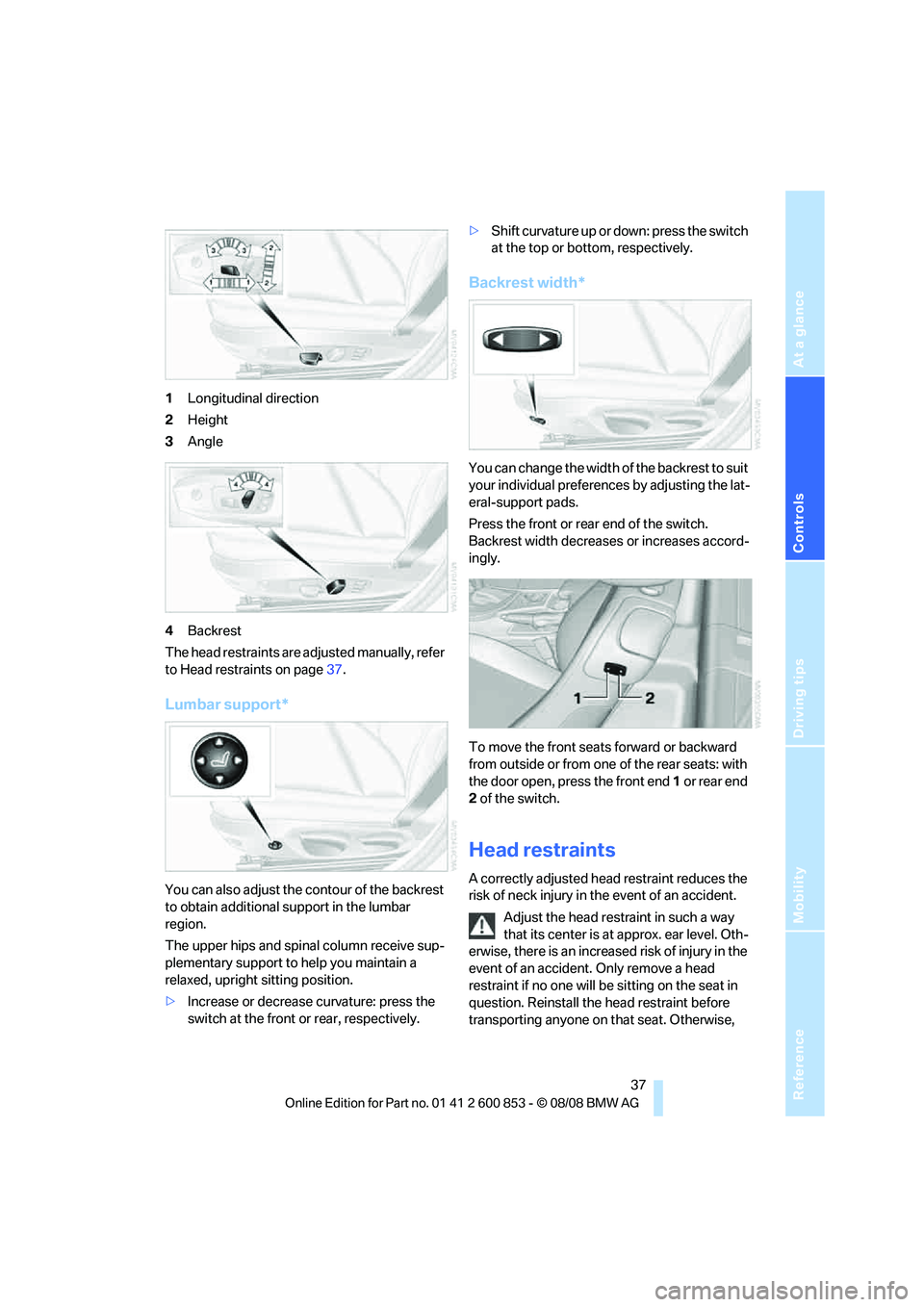
Reference
At a glance
Controls
Driving tips
Mobility
37
1Longitudinal direction
2Height
3Angle
4Backrest
The head restraints are adjusted manually, refer
to Head restraints on page37.
Lumbar support*
You can also adjust the contour of the backrest
to obtain additional support in the lumbar
region.
The upper hips and spinal column receive sup-
plementary support to help you maintain a
relaxed, upright sitting position.
>Increase or decrease curvature: press the
switch at the front or rear, respectively.>Shift curvature up or down: press the switch
at the top or bottom, respectively.
Backrest width*
You can change the width of the backrest to suit
your individual preferences by adjusting the lat-
eral-support pads.
Press the front or rear end of the switch.
Backrest width decreases or increases accord-
ingly.
To move the front seats forward or backward
from outside or from one of the rear seats: with
the door open, press the front end 1 or rear end
2 of the switch.
Head restraints
A correctly adjusted head restraint reduces the
risk of neck injury in the event of an accident.
Adjust the head restraint in such a way
that its center is at approx. ear level. Oth-
erwise, there is an increased risk of injury in the
event of an accident. Only remove a head
restraint if no one will be sitting on the seat in
question. Reinstall the head restraint before
transporting anyone on that seat. Otherwise,
Page 42 of 166
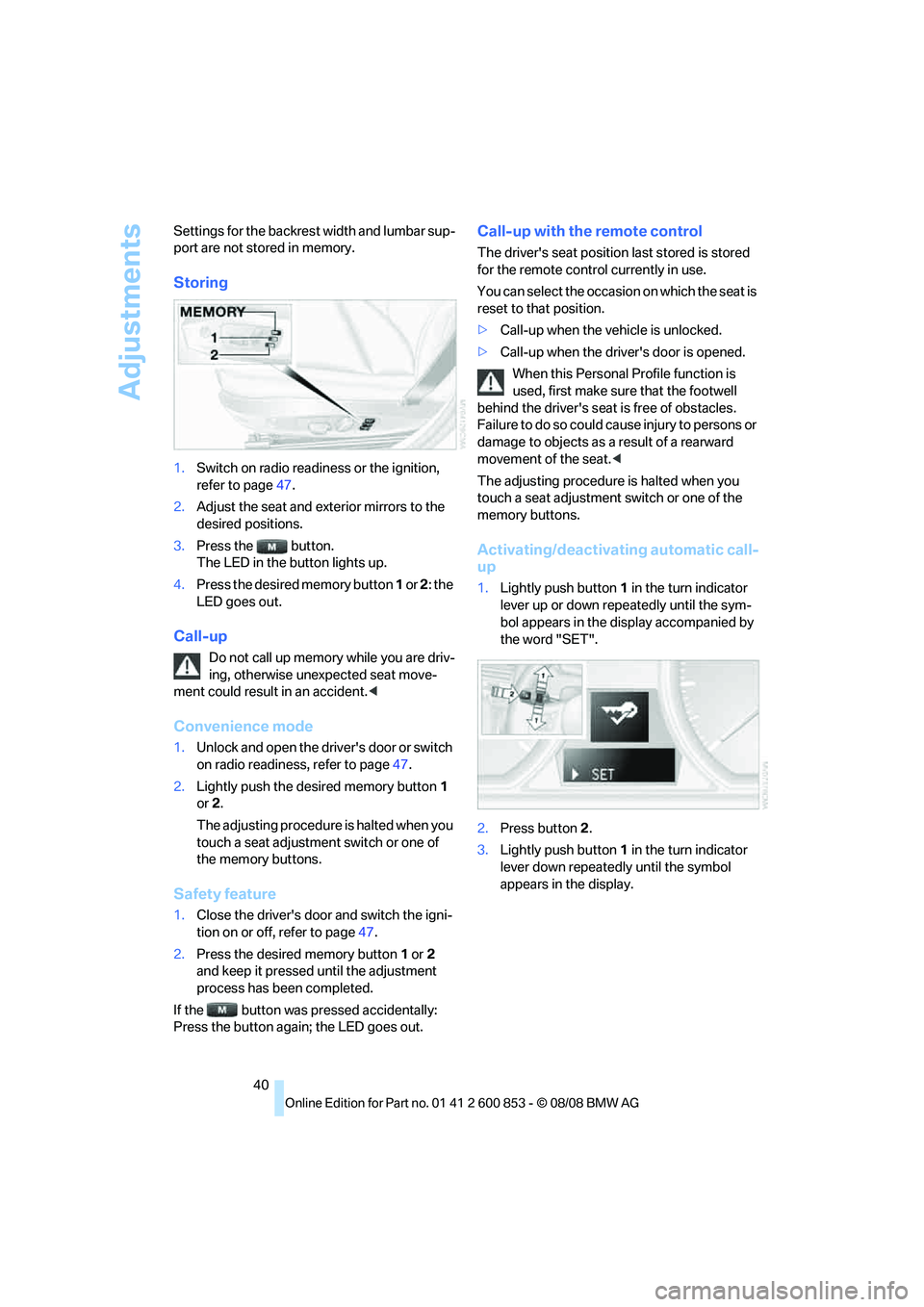
Adjustments
40 Settings for the backrest width and lumbar sup-
port are not stored in memory.
Storing
1.Switch on radio readiness or the ignition,
refer to page47.
2.Adjust the seat and exterior mirrors to the
desired positions.
3.Press the button.
The LED in the button lights up.
4.Press the desired memory button 1 or 2: the
LED goes out.
Call-up
Do not call up memory while you are driv-
ing, otherwise unexpected seat move-
ment could result in an accident.<
Convenience mode
1.Unlock and open the driver's door or switch
on radio readiness, refer to page47.
2.Lightly push the desired memory button1
or 2.
The adjusting procedure is halted when you
touch a seat adjustment switch or one of
the memory buttons.
Safety feature
1.Close the driver's door and switch the igni-
tion on or off, refer to page47.
2.Press the desired memory button1 or2
and keep it pressed until the adjustment
process has been completed.
If the button was pressed accidentally:
Press the button again; the LED goes out.
Call-up with the remote control
The driver's seat position last stored is stored
for the remote control currently in use.
You can select the occasion on which the seat is
reset to that position.
>Call-up when the vehicle is unlocked.
>Call-up when the driver's door is opened.
When this Personal Profile function is
used, first make sure that the footwell
behind the driver's seat is free of obstacles.
Failure to do so could cause injury to persons or
damage to objects as a result of a rearward
movement of the seat.<
The adjusting procedure is halted when you
touch a seat adjustment switch or one of the
memory buttons.
Activating/deactivating automatic call-
up
1.Lightly push button1 in the turn indicator
lever up or down repeatedly until the sym-
bol appears in the display accompanied by
the word "SET".
2.Press button 2.
3.Lightly push button1 in the turn indicator
lever down repeatedly until the symbol
appears in the display.
Page 46 of 166
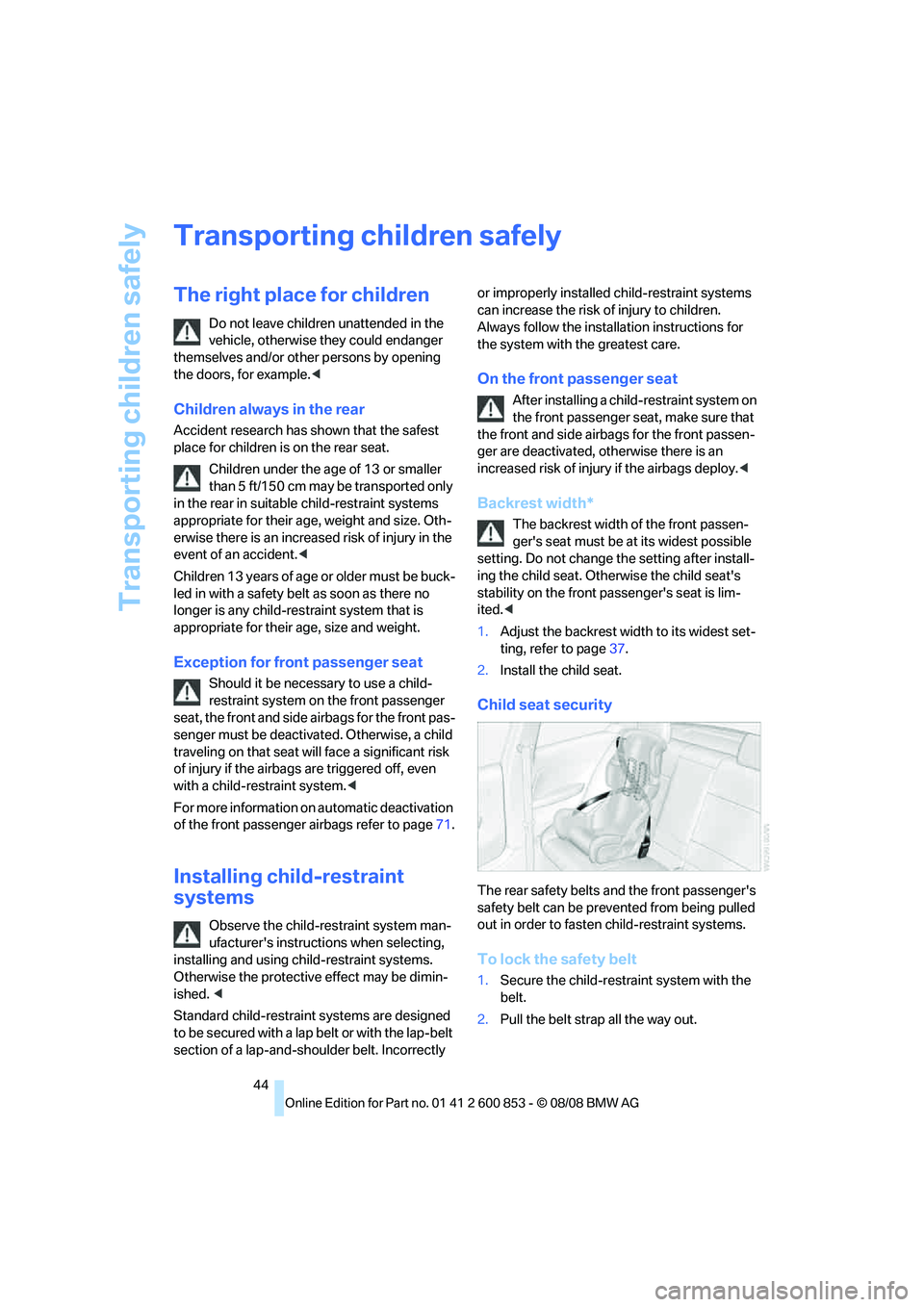
Transporting children safely
44
Transporting children safely
The right place for children
Do not leave children unattended in the
vehicle, otherwise they could endanger
themselves and/or other persons by opening
the doors, for example.<
Children always in the rear
Accident research has shown that the safest
place for children is on the rear seat.
Children under the age of 13 or smaller
than 5 ft/150 cm may be transported only
in the rear in suitable child-restraint systems
appropriate for their age, weight and size. Oth-
erwise there is an increased risk of injury in the
event of an accident.<
Children 13 years of age or older must be buck-
led in with a safety belt as soon as there no
longer is any child-restraint system that is
appropriate for their age, size and weight.
Exception for front passenger seat
Should it be necessary to use a child-
restraint system on the front passenger
seat, the front and side airbags for the front pas-
senger must be deactivated. Otherwise, a child
traveling on that seat will face a significant risk
of injury if the airbags are triggered off, even
with a child-restraint system.<
For more information on automatic deactivation
of the front passenger airbags refer to page71.
Installing child-restraint
systems
Observe the child-restraint system man-
ufacturer's instructions when selecting,
installing and using child-restraint systems.
Otherwise the protective effect may be dimin-
ished. <
Standard child-restraint systems are designed
to be secured with a lap belt or with the lap-belt
section of a lap-and-shoulder belt. Incorrectly or improperly installed child-restraint systems
can increase the risk of injury to children.
Always follow the installation instructions for
the system with the greatest care.
On the front passenger seat
After installing a child-restraint system on
the front passenger seat, make sure that
the front and side airbags for the front passen-
ger are deactivated, otherwise there is an
increased risk of injury if the airbags deploy.<
Backrest width*
The backrest width of the front passen-
ger's seat must be at its widest possible
setting. Do not change the setting after install-
ing the child seat. Otherwise the child seat's
stability on the front passenger's seat is lim-
ited.<
1.Adjust the backrest width to its widest set-
ting, refer to page37.
2.Install the child seat.
Child seat security
The rear safety belts and the front passenger's
safety belt can be prevented from being pulled
out in order to fasten child-restraint systems.
To lock the safety belt
1.Secure the child-restraint system with the
belt.
2.Pull the belt strap all the way out.
Page 112 of 166
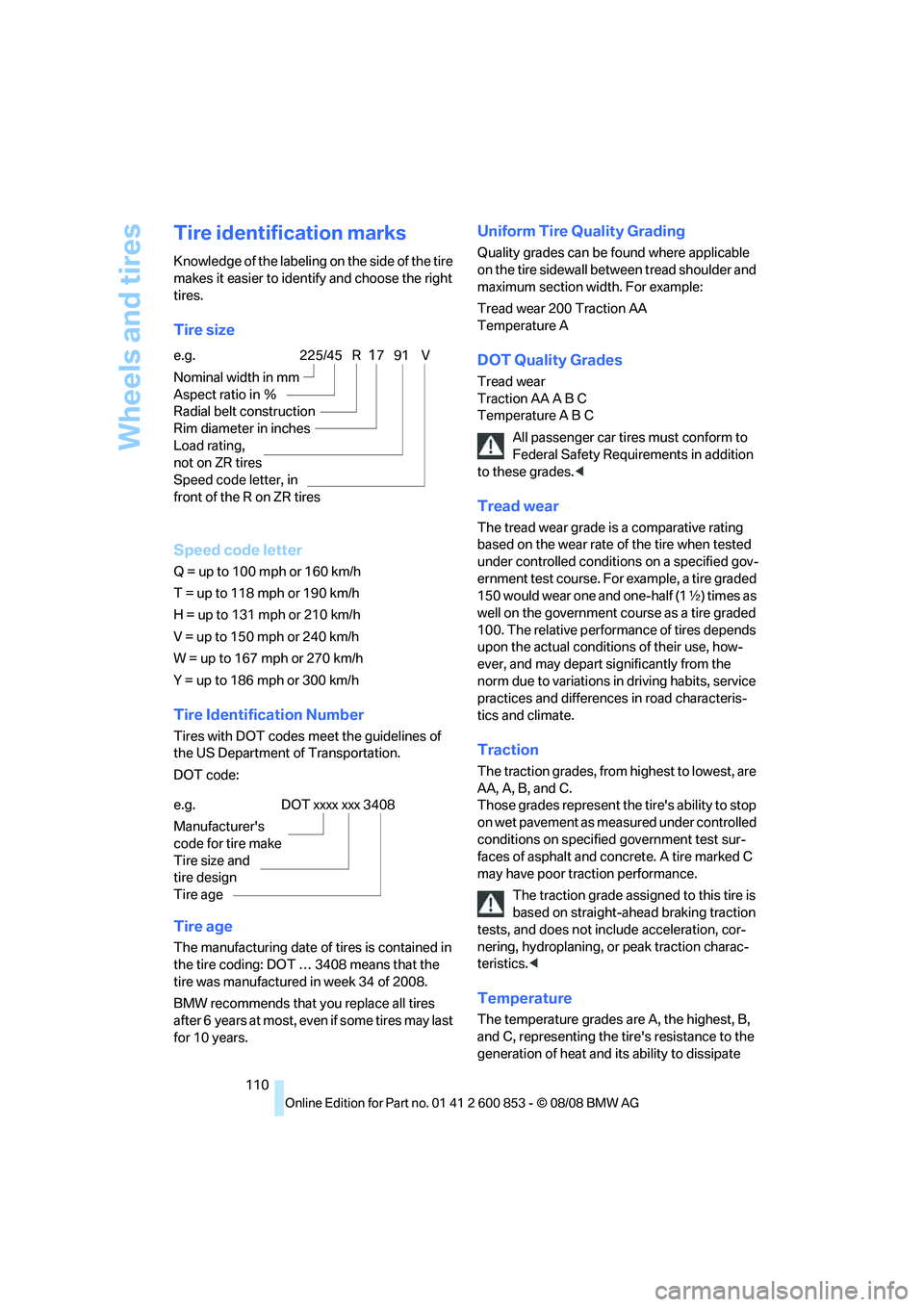
Wheels and tires
110
Tire identification marks
Knowledge of the labeling on the side of the tire
makes it easier to identify and choose the right
tires.
Tire size
Speed code letter
Q = up to 100 mph or 160 km/h
T = up to 118 mph or 190 km/h
H = up to 131 mph or 210 km/h
V = up to 150 mph or 240 km/h
W = up to 167 mph or 270 km/h
Y = up to 186 mph or 300 km/h
Tire Identification Number
Tires with DOT codes meet the guidelines of
the US Department of Transportation.
DOT code:
Tire age
The manufacturing date of tires is contained in
the tire coding: DOT … 3408 means that the
tire was manufactured in week 34 of 2008.
BMW recommends that you replace all tires
after 6 years at most, even if some tires may last
for 10 years.
Uniform Tire Quality Grading
Quality grades can be found where applicable
on the tire sidewall between tread shoulder and
maximum section width. For example:
Tread wear 200 Traction AA
Temperature A
DOT Quality Grades
Tread wear
Traction AA A B C
Temperature A B C
All passenger car tires must conform to
Federal Safety Requirements in addition
to these grades.<
Tread wear
The tread wear grade is a comparative rating
based on the wear rate of the tire when tested
under controlled conditions on a specified gov-
ernment test course. For example, a tire graded
150 would wear one and one-half (1γ) times as
well on the government course as a tire graded
100. The relative performance of tires depends
upon the actual conditions of their use, how-
ever, and may depart significantly from the
norm due to variations in driving habits, service
practices and differences in road characteris-
tics and climate.
Traction
The traction grades, from highest to lowest, are
AA, A, B, and C.
Those grades represent the tire's ability to stop
on wet pavement as measured under controlled
conditions on specified government test sur-
faces of asphalt and concrete. A tire marked C
may have poor traction performance.
The traction grade assigned to this tire is
based on straight-ahead braking traction
tests, and does not include acceleration, cor-
nering, hydroplaning, or peak traction charac-
teristics.<
Temperature
The temperature grades are A, the highest, B,
and C, representing the tire's resistance to the
generation of heat and its ability to dissipate
e.g.
Nominal width in mm
Aspect ratio in Ξ
Radial belt construction
Rim diameter in inches
Load rating,
not on ZR tires
Speed code letter, in
front of the R on ZR tires225/45 R1791 V
e.g.
Manufacturer's
code for tire make
Tire size and
tire design
Tire ageDOT xxxx xxx 3408
Page 122 of 166
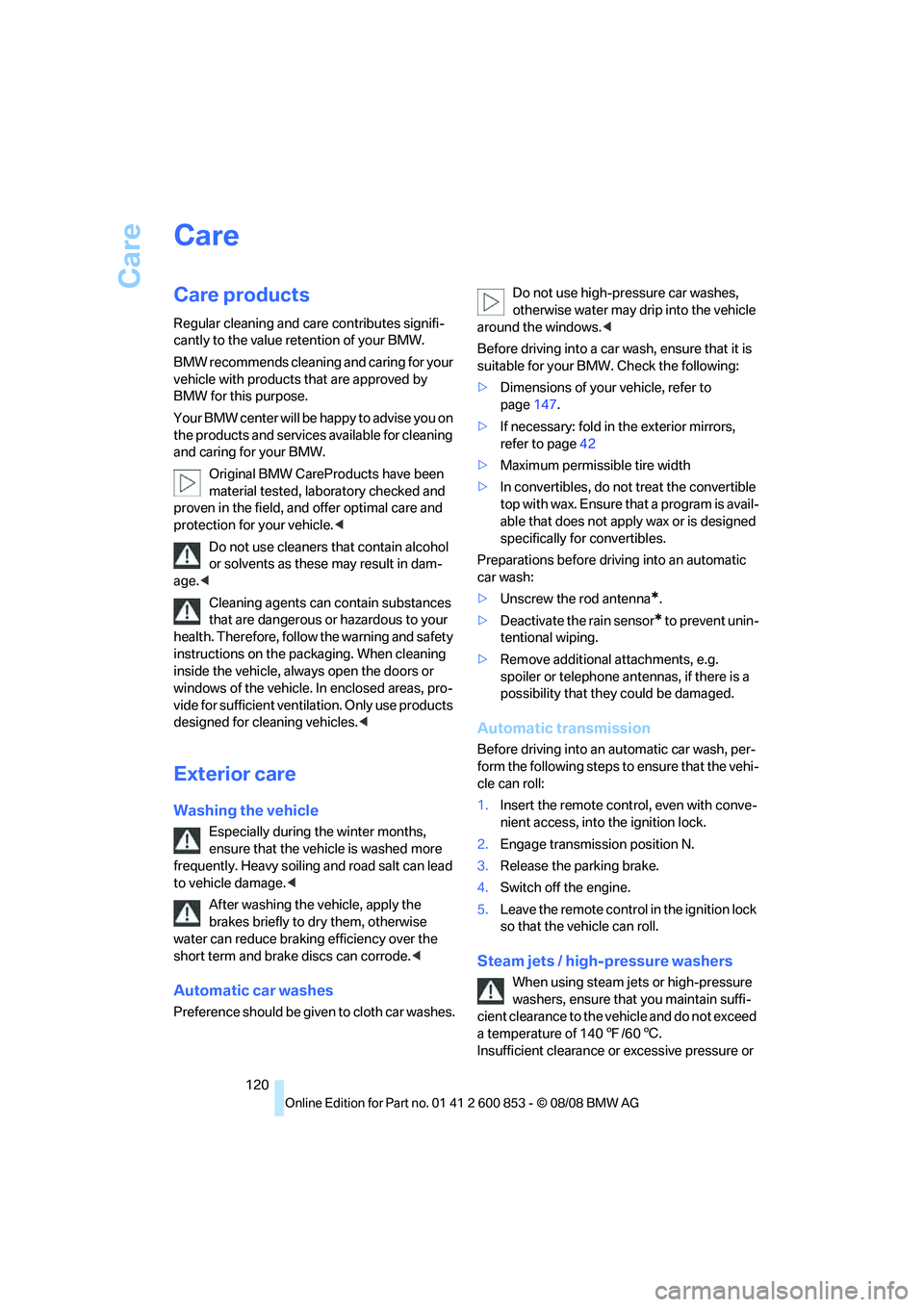
Care
120
Care
Care products
Regular cleaning and care contributes signifi-
cantly to the value retention of your BMW.
BMW recommends cleaning and caring for your
vehicle with products that are approved by
BMW for this purpose.
Your BMW center will be happy to advise you on
the products and services available for cleaning
and caring for your BMW.
Original BMW CareProducts have been
material tested, laboratory checked and
proven in the field, and offer optimal care and
protection for your vehicle.<
Do not use cleaners that contain alcohol
or solvents as these may result in dam-
age.<
Cleaning agents can contain substances
that are dangerous or hazardous to your
health. Therefore, follow the warning and safety
instructions on the packaging. When cleaning
inside the vehicle, always open the doors or
windows of the vehicle. In enclosed areas, pro-
vide for sufficient ventilation. Only use products
designed for cleaning vehicles.<
Exterior care
Washing the vehicle
Especially during the winter months,
ensure that the vehicle is washed more
frequently. Heavy soiling and road salt can lead
to vehicle damage.<
After washing the vehicle, apply the
brakes briefly to dry them, otherwise
water can reduce braking efficiency over the
short term and brake discs can corrode.<
Automatic car washes
Preference should be given to cloth car washes.Do not use high-pressure car washes,
otherwise water may drip into the vehicle
around the windows.<
Before driving into a car wash, ensure that it is
suitable for your BMW. Check the following:
>Dimensions of your vehicle, refer to
page147.
>If necessary: fold in the exterior mirrors,
refer to page42
>Maximum permissible tire width
>In convertibles, do not treat the convertible
top with wax. Ensure that a program is avail-
able that does not apply wax or is designed
specifically for convertibles.
Preparations before driving into an automatic
car wash:
>Unscrew the rod antenna
*.
>Deactivate the rain sensor
* to prevent unin-
tentional wiping.
>Remove additional attachments, e.g.
spoiler or telephone antennas, if there is a
possibility that they could be damaged.
Automatic transmission
Before driving into an automatic car wash, per-
form the following steps to ensure that the vehi-
cle can roll:
1.Insert the remote control, even with conve-
nient access, into the ignition lock.
2.Engage transmission position N.
3.Release the parking brake.
4.Switch off the engine.
5.Leave the remote control in the ignition lock
so that the vehicle can roll.
Steam jets / high-pressure washers
When using steam jets or high-pressure
washers, ensure that you maintain suffi-
cient clearance to the vehicle and do not exceed
a temperature of 1407/606.
Insufficient clearance or excessive pressure or
Page 154 of 166
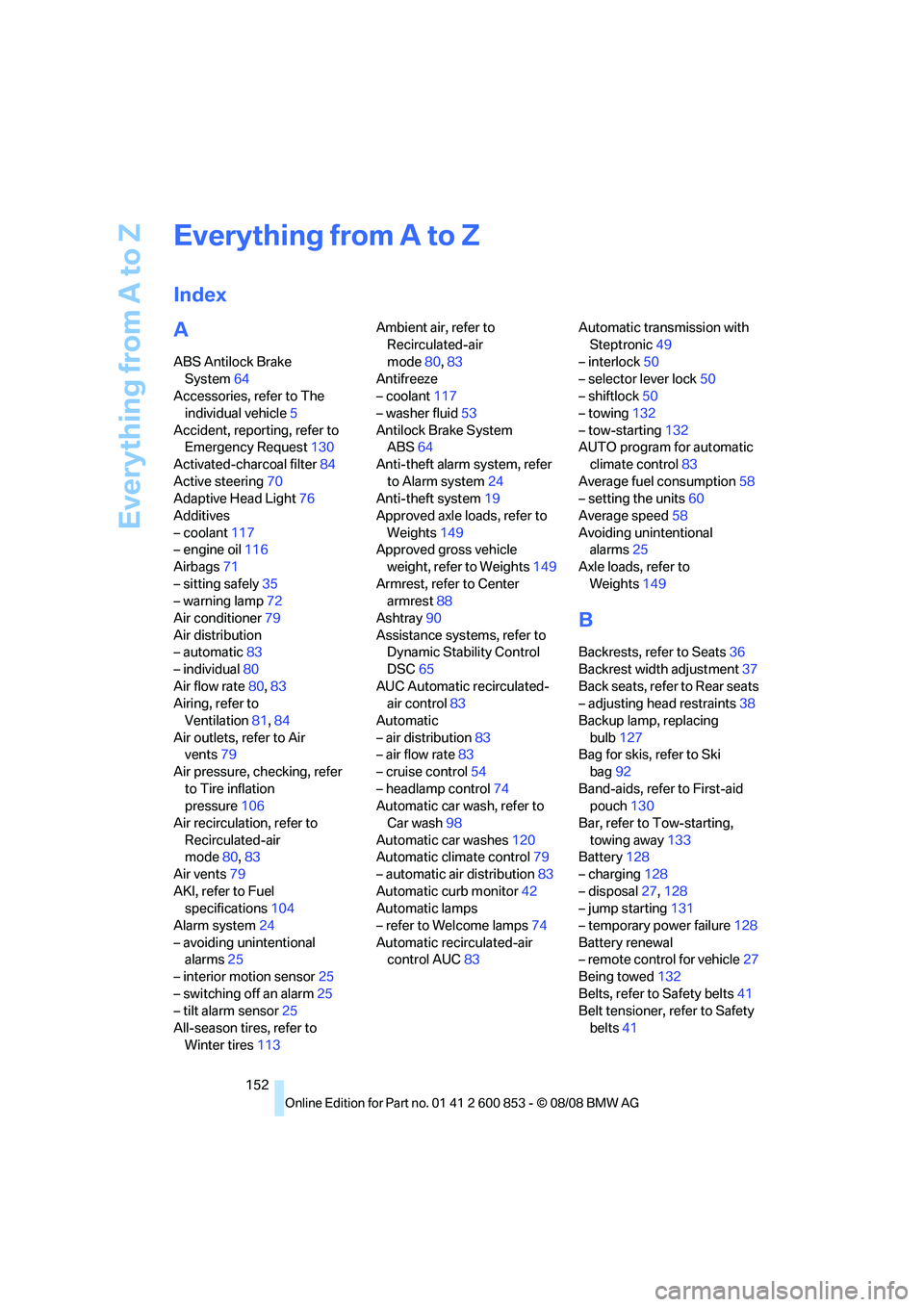
Everything from A to Z
152
Everything from A to Z
Index
A
ABS Antilock Brake
System64
Accessories, refer to The
individual vehicle5
Accident, reporting, refer to
Emergency Request130
Activated-charcoal filter84
Active steering70
Adaptive Head Light76
Additives
– coolant117
– engine oil116
Airbags71
– sitting safely35
– warning lamp72
Air conditioner79
Air distribution
– automatic83
– individual80
Air flow rate80,83
Airing, refer to
Ventilation81,84
Air outlets, refer to Air
vents79
Air pressure, checking, refer
to Tire inflation
pressure106
Air recirculation, refer to
Recirculated-air
mode80,83
Air vents79
AKI, refer to Fuel
specifications104
Alarm system24
– avoiding unintentional
alarms25
– interior motion sensor25
– switching off an alarm25
– tilt alarm sensor25
All-season tires, refer to
Winter tires113Ambient air, refer to
Recirculated-air
mode80,83
Antifreeze
– coolant117
– washer fluid53
Antilock Brake System
ABS64
Anti-theft alarm system, refer
to Alarm system24
Anti-theft system19
Approved axle loads, refer to
Weights149
Approved gross vehicle
weight, refer to Weights149
Armrest, refer to Center
armrest
88
Ashtray90
Assistance systems, refer to
Dynamic Stability Control
DSC65
AUC Automatic recirculated-
air control83
Automatic
– air distribution83
– air flow rate83
– cruise control54
– headlamp control74
Automatic car wash, refer to
Car wash98
Automatic car washes120
Automatic climate control79
– automatic air distribution83
Automatic curb monitor42
Automatic lamps
– refer to Welcome lamps74
Automatic recirculated-air
control AUC83Automatic transmission with
Steptronic49
– interlock50
– selector lever lock50
– shiftlock50
– towing132
– tow-starting132
AUTO program for automatic
climate control83
Average fuel consumption58
– setting the units60
Average speed58
Avoiding unintentional
alarms25
Axle loads, refer to
Weights149
B
Backrests, refer to Seats36
Backrest width adjustment37
Back seats, refer to Rear seats
– adjusting head restraints38
Backup lamp, replacing
bulb127
Bag for skis, refer to Ski
bag92
Band-aids, refer to First-aid
pouch130
Bar, refer to Tow-starting,
towing away133
Battery128
– charging128
– disposal27,128
– jump starting131
– temporary power failure128
Battery renewal
– remote control for vehicle27
Being towed132
Belts, refer to Safety belts41
Belt tensioner, refer to Safety
belts41
Page 163 of 166
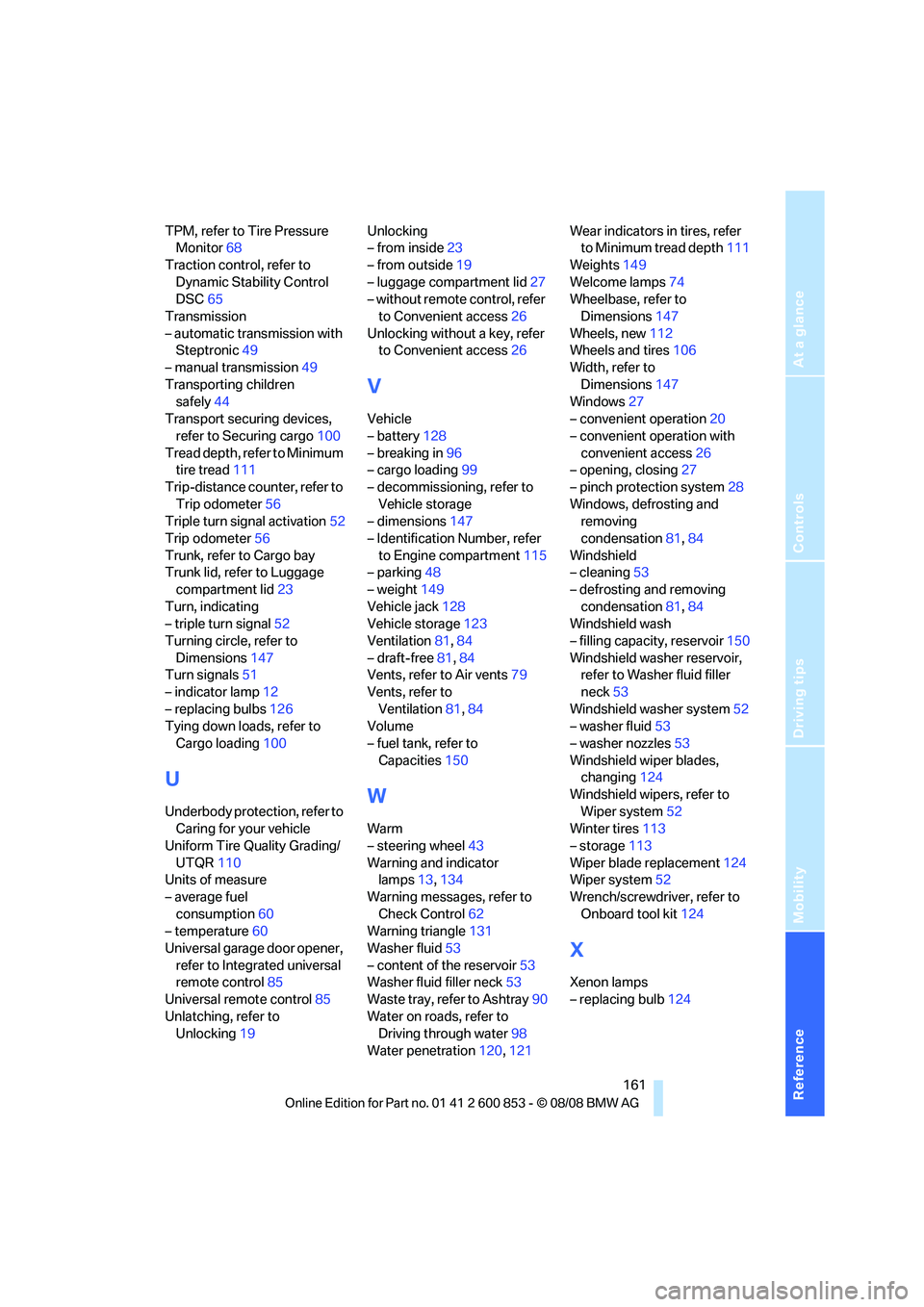
Reference
At a glance
Controls
Driving tips
Mobility
161
TPM, refer to Tire Pressure
Monitor68
Traction control, refer to
Dynamic Stability Control
DSC65
Transmission
– automatic transmission with
Steptronic49
– manual transmission49
Transporting children
safely44
Transport securing devices,
refer to Securing cargo100
Tread depth, refer to Minimum
tire tread111
Trip-distance counter, refer to
Trip odometer56
Triple turn signal activation52
Trip odometer56
Trunk, refer to Cargo bay
Trunk lid, refer to Luggage
compartment lid23
Turn, indicating
– triple turn signal52
Turning circle, refer to
Dimensions147
Turn signals51
– indicator lamp12
– replacing bulbs126
Tying down loads, refer to
Cargo loading100
U
Underbody protection, refer to
Caring for your vehicle
Uniform Tire Quality Grading/
UTQR110
Units of measure
– average fuel
consumption60
– temperature60
Universal garage door opener,
refer to Integrated universal
remote control85
Universal remote control85
Unlatching, refer to
Unlocking19Unlocking
– from inside23
– from outside19
– luggage compartment lid27
– without remote control, refer
to Convenient access26
Unlocking without a key, refer
to Convenient access26
V
Vehicle
– battery128
– breaking in96
– cargo loading99
– decommissioning, refer to
Vehicle storage
– dimensions147
– Identification Number, refer
to Engine compartment115
– parking48
– weight149
Vehicle jack128
Vehicle storage123
Ventilation81,84
– draft-free81,84
Vents, refer to Air vents79
Vents, refer to
Ventilation81,84
Volume
– fuel tank, refer to
Capacities150
W
Warm
– steering wheel43
Warning and indicator
lamps13,134
Warning messages, refer to
Check Control62
Warning triangle131
Washer fluid53
– content of the reservoir53
Washer fluid filler neck53
Waste tray, refer to Ashtray90
Water on roads, refer to
Driving through water98
Water penetration120,121Wear indicators in tires, refer
to Minimum tread depth111
Weights149
Welcome lamps74
Wheelbase, refer to
Dimensions147
Wheels, new112
Wheels and tires106
Width, refer to
Dimensions147
Windows27
– convenient operation20
– convenient operation with
convenient access26
– opening, closing27
– pinch protection system28
Windows, defrosting and
removing
condensation81,84
Windshield
– cleaning53
– defrosting and removing
condensation81,84
Windshield wash
– filling capacity, reservoir150
Windshield washer reservoir,
refer to Washer fluid filler
neck53
Windshield washer system52
– washer fluid53
– washer nozzles53
Windshield wiper blades,
changing124
Windshield wipers, refer to
Wiper system52
Winter tires113
– storage113
Wiper blade replacement124
Wiper system52
Wrench/screwdriver, refer to
Onboard tool kit124
X
Xenon lamps
– replacing bulb124